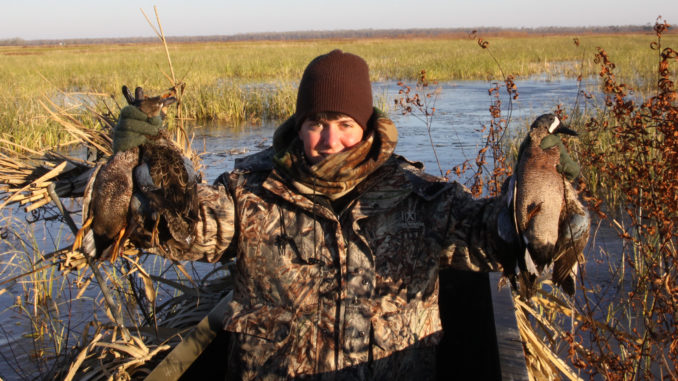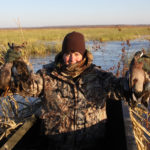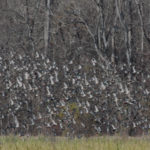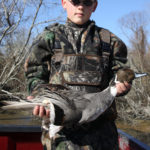
Toward the end of the blind in a low voice, 13-year old Michael Price from Alexandria, gave a log drawn out, “Wowwww!” that quietly trailed off.
In the air were literally hundreds of ducks, racing seemingly in every direction out in front, to the sides and behind the blind. Some flew directly over the top so close you could hear their wings working as speed breaks cutting the air as they descended.
Price’s blind mate on the Sherburne WMA youth lottery hunt, Kyler Campbell, cradled his shotgun in the crooks of his arms looking skyward, seemingly just taking it all in.
Suddenly, the popping sound of shotguns could be heard coming from the other blinds that also held youth off in the distance.
“Y’all can shoot if you have a shot,” Louisiana Department of Wildlife and Fisheries biologist Brad Launey. He was acting as the guide for the morning hunt. “There’s no need for me to call right now; they’ve got birds everywhere.”
With their fathers watching on, both young hunters fired their guns at ducks as they came in range of the blind, flying over the decoys out front.
For several years, the LDWF has been hosting youth lottery waterfowl hunts on Sherburne’s North Farm. Located between Lafayette and Baton Rouge off of I-10, the WMA rests in the wildlife-rich bottomland hardwood region of the Atchafalaya Basin. Strictly managed, the lottery youth hunt on the North Farm is nothing short of spectacular and a hunt a young person will never forget.
The deadline for youth lottery applications is Oct. 8.
Sherburne WMA Manager Tony Vidrine described the genesis of the North Farm youth hunt.
“The North Farm was always a waterfowl refuge that we didn’t have good access to because there was private property between us and the levee,” he said. “When the late Robert Helm was the department’s waterfowl study leader, we talked about trying to develop a waterfowl youth hunt there. I got with the farmers who owned the property between us, and they didn’t have a problem with us holding a youth hunt. So we signed a letter of understanding that they would let us pass, bringing the public through their roads, to have these hunts.”
For being only 16, Campbell seemed seasoned well beyond his years. You couldn’t help but notice that the young hunter from Dry Creek was being selective in the early light as numerous teal and shovelers passed during those moments before sunrise. What’s more, by hunt’s end, he had taken only a few shots.
“There’s definitely plenty of ducks around here,” he said. “We have a lease down in Little Chenier, just north of Grand Chenier in Cameron Parish, and I’ve been duck hunting since I was about 9 years old. But mallards and pintails, that’s what most everyone wants to shoot, so sometimes you pass on the spoonbills.
“You look back at it and wished you’d have shot those two or three spoonbills that came over. But this is an excellent hunt and they treat you well out here. The guide and everything, they treat you well.”
Campbell was able to set back and appreciate the Sherburne North Farm youth hunt in ways perhaps some of the other hunters couldn’t.
One of the rookies was 11-year-old Clay Guillory, a Bayou Chicot Middle School sixth-grader from Pine Prairie.
Guillory shot his first pintail — a bull sprig — that was nearly as big as he was. Guillory will remember for the rest of his life the shot, the bird and perhaps more, sharing the blind with his father. Each blind is large enough to hold two hunters, their escorts and the LDWF guide.
Thirteen-year-old Lindsey Brewer, from Lafayette, made her first duck hunt during the youth hunt, and was accompanied by her godfather, Rusty Goulas. Though Brewer’s father hunts, he asked her uncle, an avid waterfowl hunter, if he would escort her because they were unsure if there was anyone to do the calling.
“It was fun,” Brewer recounted of her hunt during lunch provided by department staffers on the refuge. “It was my first time ever duck hunting, and I shot a teal. I shot at some other ones, and I almost got them, but I missed. My blind was big, and you could fit a lot of people in it and move around. So it was fun, and I’m glad I got to go.”
Goulas was ecstatic for Brewer, and looked forward to her putting in for the lottery hunt this year. Moreover, he was amazed at how the youth hunters were catered to.
“The set up is just awesome,” he said. “It’s great for the kids. You’re able to drive right
up to the blind, and they didn’t have to get their feet wet. We went by boat, and it was a perfect set up.
“They had too many ducks sometimes. We were often competing with the live ones landing near the blind when we called them.”
For some of the young hunters, Sherburne’s North Farm youth hunt wasn’t their first rodeo. Some previously hunted Sherburne or one of the other department youth hunts offered elsewhere in the state.
Trent Estopinal, 16, a St. Michael High School student from Baton Rouge, had hunted Sherburne WMA previously.
“I’ve been hunting my whole life, since about 3 years old,” he said. “I got picked before and limited out. This was my second time hunting here.”
Some of the hunters, like Christian Scioneaux, 15, from Vacherie and his blind mate Josh Raballais, 14, from Pineville, had the opportunity to harvest specklebelly geese as a bonus along with eye-popping limits of quality ducks — mallards, pintails and gadwalls.
Literally, a young person has an incredible opportunity to experience a fully guided, quality waterfowl hunt and see hundreds if not thousands of ducks during a morning hunt on the refuge.
Vidrine acknowledged what makes the youth hunt so special is limiting the number of hunts they hold on the refuge, leaving it, for the most part, undisturbed.
“There were always a lot of ducks in that area when we bought it,” Vidrine said. “And because we keep it as a refuge, we only hold three hunts on it. We basically don’t want to disturb it too much, and we don’t think the three hunts we hold there is enough to disturb them because the ducks continue to stay there. So three is probably enough, and we want to continue to keep it as a waterfowl refuge.”
One of the known causes of the decline in hunter participation the past decade has been limited access to land where hunting is allowed. Gone are the days when a young person could walk out the back door with his crack-barrel shotgun and go hunt in the rural woods behind the house.
Current initiatives around the country seek to change some of that; many state agencies are working to create public opportunities for youth to hunt. The LDWF is no exception.



